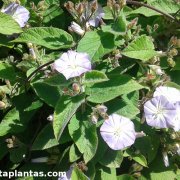Care of the climbing plant Convolvulus canariensis or Nemostima canariensis |
|
The genus Convolvulus, family Convolvulaceae, comprises 600 species of herbaceous climbing plants and shrubs with a cosmopolitan distribution. Some species are: Convolvulus canariensis, Convolvulus sabatius, Convolvulus cneorum, Convolvulus tricolor, Convolvulus sepium, Convolvulus althaeoides, Convolvulus floridus, Convolvulus mauritanicus. Scientific synonym: Nemostima canariensis. This species is native to the Canary Islands. They are evergreen climbing plants with woody stems at the base and herbaceous at the top of the plant that reach 10 meters (32.8 feet) in length. The hairy leaves are ovoid-oblong in shape and deep green in color. The showy mauve, pink or light blue flowers appear in groups of up to 7 flowers. They bloom in summer. Nemostima canariensis is used to cover walls, fences or pergolas (they need supports) and clear slopes and undergrowth. Convolvulus canariensis needs full sun or semi-shade exposure (it will flower less). It resists occasional frosts down to -5 ºC (23 ºF). The soil can be a normal, well-drained garden soil with coarse sand and abundant organic matter. Water regularly so that the substrate does not dry out completely; it resists a few days of drought. Fertilize with compost or manure in late winter. Convolvulus canariensis can be lightly pruned after flowering to control growth. Nemostima canariensis is a plant resistant to the usual pests and diseases. Convolvulus canariensis is propagated by cuttings in the fall and from seeds sown in the spring. |
Images of the climbing plant Convolvulus canariensis or Nemostima canariensis |
Find plants
Convolvulus canariensis or Nemostima canariensis | Care and Growing
© 2026 FavThemes


